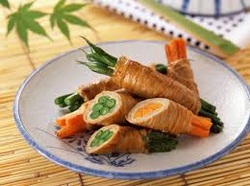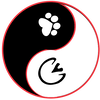 Food Therapy is one of the five branches of Traditional Chinese Veterinary Medicine. It is a practice of healing using natural foods along with or instead of medications. The Yellow Emperor's Classic of Internal Medicine (Huang-di-ni-jing, written around 300 BC) was most important in forming the basis of Chinese food therapy. It classified food by Yin and Yang food group and five tastes and by their natures and characteristics. For example, Yang foods are believed to warm Yang, tonify Qi, dispel Cold, move Qi and Blood, resolve stagnation, stop pain. Yin foods nourish Yin, cool blood, clear heat, detoxify. Therefore, Yang foods (e.g., mutton and pumpkin) are used for Qi/Yang Deficiency, Qi-blood stagnation, wei syndrome, Lin syndrome, immunodeficiency. Yin Foods (such as turkey and tofu) are used for the treatment of Yin Deficiency, skin itching, autoimmune diseases, Cushing's disease. Food Therapy is the preparation of using selected food ingredients and superior herbs. The goals of food therapy are
Whole, fresh foods should be a big part of your animal's diet. Processed foods and vitamin isolates lack the phytonutrients, enzymes and building blocks of whole foods. The first step to good nutrition is a variety of quality whole foods. When clients start home cooking for their dogs and cats, I recommend feeding platinum performance for support as a good adjunct to your home cooking. Here is the link to platinum performance, use code YIN when checking out.
0 Comments
|
�
Dr. WendyPractices Traditional Chinese Veterinary Medicine in Sarasota, Florida Categories
All
Archives
December 2023
|
|




 RSS Feed
RSS Feed

